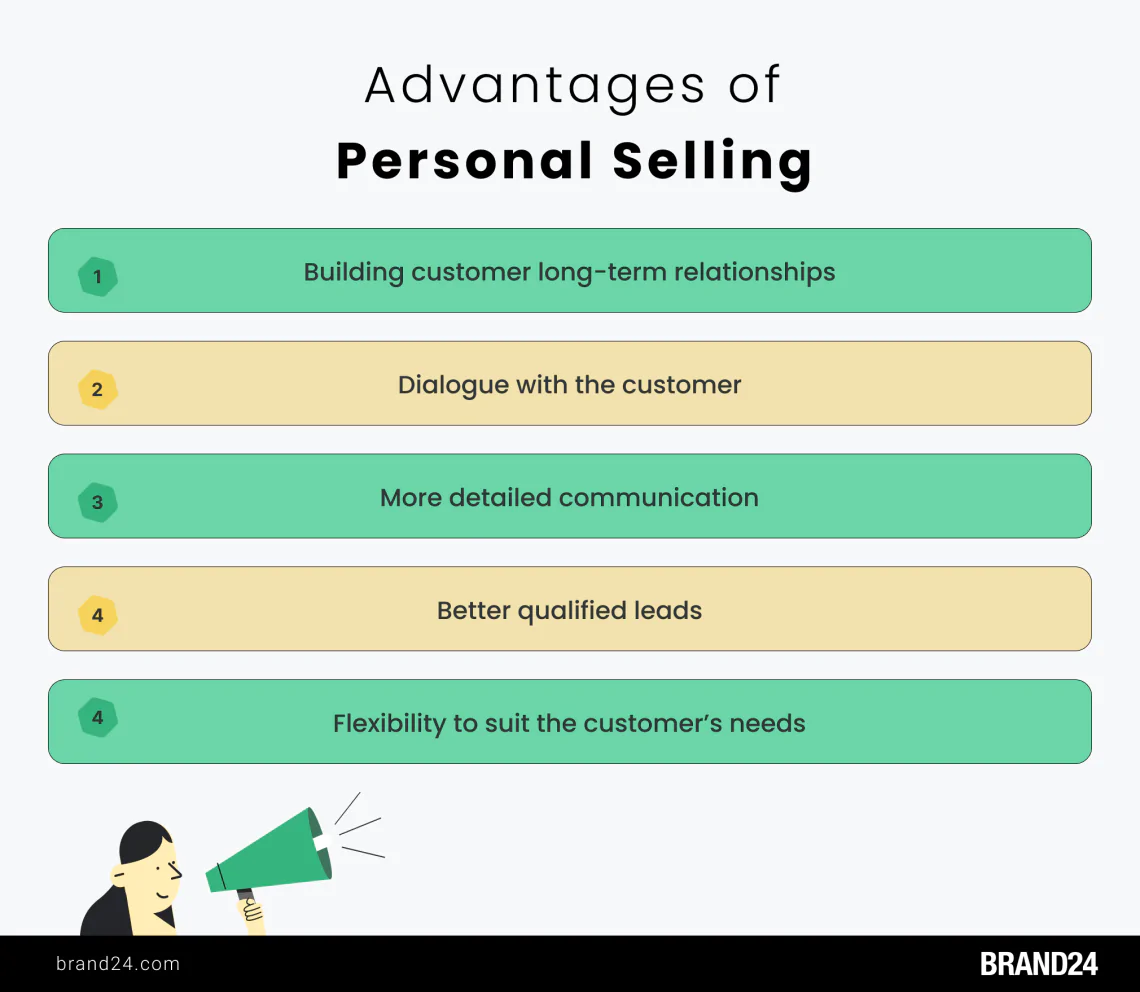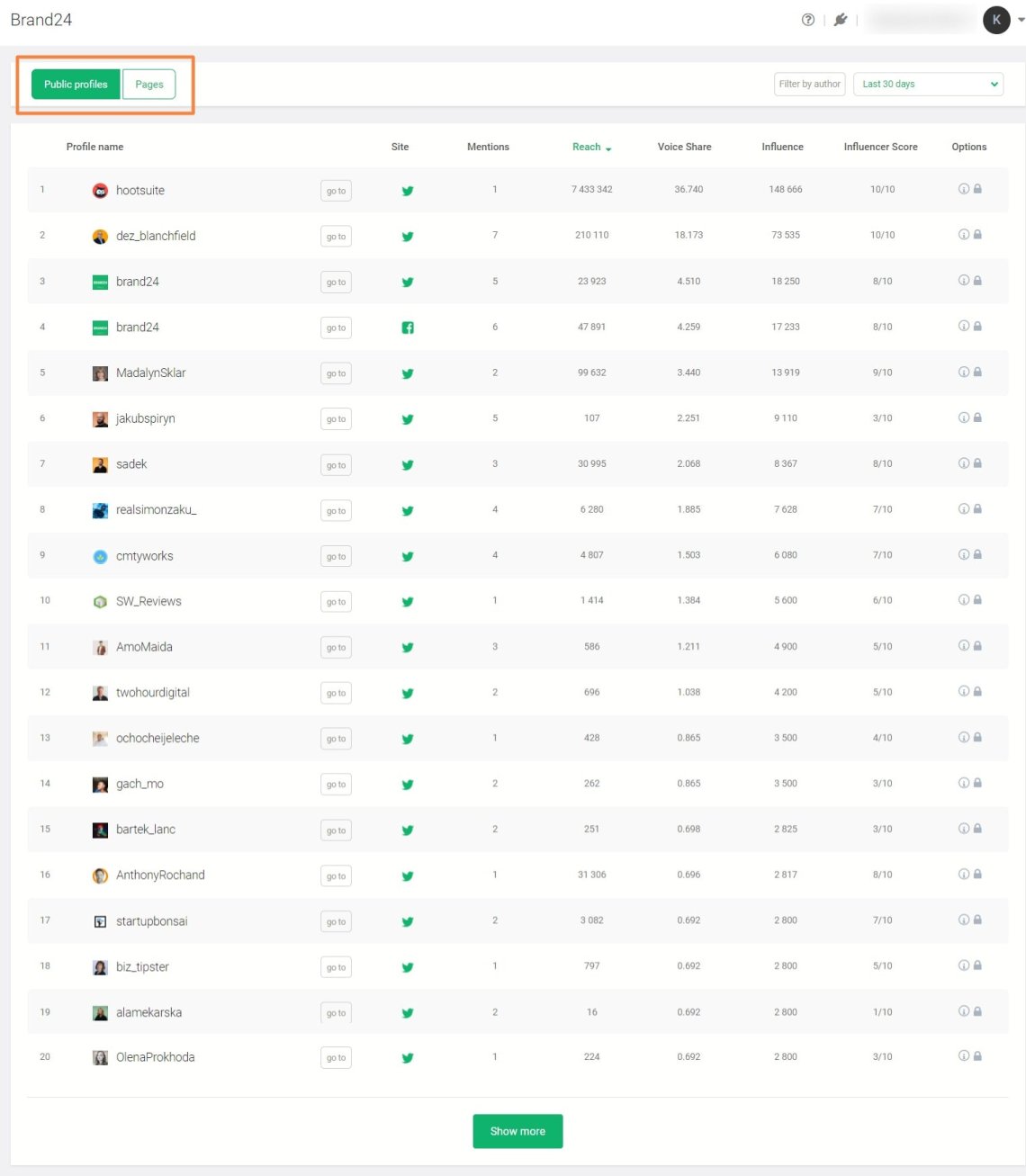What is Personal Selling? Definition and Process [2025]
Table of contents
Do you need to close more sales? Personal selling is a type of person-to-person communication that consists in persuading a customer to buy a product or service by using interpersonal skills. The salesperson uses their knowledge of the product or service, market, and prospects to build a relationship and convince them to make a purchase.
By using personal selling, you can increase your chances of making a sale. You will be able to connect with customers on a more personal level, which will help you understand their needs and wants. This will allow you to provide them with exactly what they are looking for.
Read on to find out more about personal selling and how media monitoring can help you with it!
Why is Personal Selling Worth it?
To help you understand the power of personal selling, let’s look at some cold, hard data.
- 80% of consumers prefer a tailored experience and are more likely to do business with you if you personalize the offer. (Source)
- 81% of consumers want brands to get closer to them and know when they should approach or avoid them. (Source)
- Only 22% of consumers are satisfied with the personalization they currently experience. (Source) This should motivate you to improve and develop as there’s a large segment of the market still unsatisfied!
- Sales representatives who can defend their product well have a 64% chance of selling. (Source) Personal selling allows you to do it much more successfully.

Advantages of Personal Selling Strategies
The primary personal selling advantages are the following:
- Building customer relationships: You can build long-term relationships with your customers when you meet with them face-to-face. This is essential for developing trust and loyalty.
- Dialogue with the customer: Personal selling allows for a two-way dialogue between the salesperson and the customer. This is the best way to understand their needs and wants.
- More detailed communication: When you meet with a customer in person, you can provide them with more detailed information about your product or service. You can also answer any questions they may have.
- Better qualified leads: Since personal selling entails a lot of research that goes into qualifying leads, they are of better quality and result in a sale more often.
- Flexibility: You can adjust your pitch on the fly to better suit the customer’s needs.
Still, it Doesn’t Come Without Drawbacks
Some of the main personal selling disadvantages are as follows:
- High cost: Personal selling can be costly, as it requires you to send sales representatives out to meet with customers in-person.
- More time and effort: Personal selling takes more time and effort than other forms of advertising because it requires a one-on-one interaction between the seller and the buyer. The seller must be able to build a rapport with the buyer and understand their needs to close the sale.
- Limited reach: Personal selling entails limited reach because it is a direct form of communication between a salesperson and a customer. This type of communication makes it difficult to reach many people, which limits the number of potential customers that can be reached.
7-steps of the Personal Selling Process
Let’s explain personal selling using the typical 7-step sales process.

01 Prospecting
Prospecting is the act of identifying potential customers and qualifying them as prospects. This involves determining whether or not they have a need or problem that your product or service can solve, and whether or not they are likely to purchase what you are selling.
Prospecting is the first step in the sales process because it is essential to identify and qualify potential customers before you invest time and energy in trying to sell to them.
How to find a potential client (prospect)?
The better potential customer knows your brand or product, the bigger your chances of closing a deal. So how about reaching people that already mentioned you online?
You can do it by using a media monitoring tool that gathers data about who is talking about you online. Furthermore, such a tool presents some very interesting insights, such as:
- Top public profiles
- Most active public profiles
- Most active sites
- The most influential sites
As a result, you will discover a list of profiles and pages that match your business:

Brand24 is a tool that detects social profiles and sites that match your business.
02 Preparation
When preparing to sell to a potential customer, it is important to do your research and collect all the relevant information about them and your product or service. You should have a good understanding of their needs and what solutions you can offer them.
You should also be prepared to answer any questions they may have about your product or service. It is important to be professional and confident when speaking to potential customers, so make sure you are well-prepared before any interactions.
03 Approach
An approach in personal selling is a way to start a conversation with a potential customer. It can be through a phone call, email, or in person. The goal is to get the customer’s attention and find out more about their problems so that you can develop an adequate next step – presentation.
Making a good first impression is essential when personal selling because it can determine whether or not the customer will be interested in what you have to say. A strong, confident approach will help create an instant connection that might make all of your efforts worthwhile!
04 Sales presentation
The presentation is a formal meeting between the salesperson and the potential customer in which the salesperson pitches their product or service. The presentation includes information about the product or service, and demonstrations or explanations of how it works.
When meeting with potential customers, you must present them in a way which reflects their needs and interests. This will help create an impression of trustworthiness as well as increase chances for success!
05 Objection handling
When personal selling, objection handling is a technique used to deal with any potential concerns a prospect may have about the product or service being offered.
This may include concerns about price, trust, urgency, or need. By addressing these concerns, the salesperson is more likely to close the sale.
When objection handling, personal selling becomes a two-way communication process. It is not just the seller talking and the buyer listening.
This way, the seller can understand the buyer’s concerns and objections, and find ways to address them. In many cases, objections are not objections at all, but just the buyer’s way of asking for more information.
06 Closing
Closing when personal selling is the process of finalizing the agreement between the buyer and seller. This includes confirming the details of the sale, such as the price and any special conditions, and getting the buyer to commit to buying the product or service. It can also involve getting the buyer to sign any necessary paperwork or providing a down payment.
A personal sale is not complete until the customer has been closed. This is an important step because it ensures that the customer has been given all of the information they need to make a purchase and that they have had an opportunity to ask any questions they may have.
07 Nurturing
Nurturing is the process of providing care and support to something or someone to help them grow or develop. In the context of personal selling, nurturing refers to the sales team reaching out to customers to ensure that they are satisfied with the onboarding process and the service they have received.
This can include providing additional support or assistance as needed, as well as follow-up calls or emails to make sure everything is going smoothly.
Nurturing helps to build customer loyalty and increases the chances of repeat business.
Being a Good Personal Sales Representative
This process involves using personal selling techniques that will give you an edge over the competition.
Be well-prepared
Successful personal selling requires more than simply knowing your product inside and out. To be truly successful, you need to be prepared with thorough research about your customer, their needs, and how your product can best meet those needs.
This research is essential to customize your sales pitch and ensure customer satisfaction.
Without it, you run the risk of coming across as unprepared and uninformed, which will quickly turn potential customers away.
Ask the right questions
It’s important to remember that not all prospective customers are alike and each has their own specific needs and wants. As a result, asking the right questions when personal selling is essential to identify those needs and wants.
Only then can you tailor your pitch in a way that will be most effective in convincing the prospective customer to make a purchase.
Get your buyer personas right
Personal selling is all about understanding your audience and customizing your sales pitches to appeal to their specific needs and interests. This is why it’s so important to get your buyer personas right.
If you don’t know who you’re selling to, it’s hard to make a sales pitch that will resonate.
You could end up speaking too broadly and not addressing the specific pain points that your prospect is looking to solve. Or, you could focus too narrowly on one aspect of the product or service and miss the opportunity to sell the full benefits.
Either way, you’ll likely end up losing the sale.
Use communication skills
Sales staff need to be able to communicate effectively to sell products or services. This means being able to explain the benefits of the product or service convincingly, and also being able to build rapport with the customer. Good communication skills can help sales staff to overcome objections and close sales.
In addition, effective communication is often essential for maintaining good customer relationships. Customers who feel valued and understood are more likely to be satisfied with their purchases, and more likely to continue doing business with the sales staff member in the future.
Follow up
When you are selling something, whether it is a product or a service, you need to follow up with your prospective buyer. This is because the buying process is not always instantaneous.
People usually need time to think about their purchase, and they may have questions that they want to be answered before they are ready to commit.
By following up, you can stay top of mind and make sure that your prospective buyer has all the information they need to make a decision.
Additionally, following up shows that you are committed to the sale and that you are willing to go the extra mile to ensure that the prospective buyer is happy with their purchase.
Practice empathy
Put yourself in your customer’s shoes. You want to buy a product, but you don’t know which one to choose. There are so many options and salespeople trying to sell you different products.
How do you decide?
The salesperson who can understand your needs and explain how their product will meet those needs is the salesperson you’re going to buy from. This is why empathy is such an important sales strategy.
When you can see things from your customer’s perspective, you can better explain how your product is the right choice for them.
Be likeable
Personal selling is all about building relationships. customers need to feel like they can trust and rely on the person they’re buying from. If they don’t like or respect the salesperson, they’re not likely to do business with them. That’s why it’s so important to be likeable when personal selling.
Of course, being likeable doesn’t mean being a pushover. Customers still need to feel like they’re getting a good deal and that their concerns are being taken seriously. But if they can see that the salesperson is genuine and cares about their needs, they’re much more likely to do business with them.
How Does Media Monitoring Help With Personal Selling?
While it entails a wide-scaled analysis of mentions, media monitoring can be useful even in such a targeted approach as personal selling.
- Identifying common pain points: This information can help you to single out areas where you need to make changes or improvements to meet the needs of your target audience.
- Lead prospecting: For example, if a company is planning to launch a new product, the media may report on consumer interest in the product and whether or not it is likely to be successful. This information can help personal sellers target leads who are likely to be interested in the product and have a higher chance of making a sale.
- Qualifying leads: Media outlets are a great source of information about a company’s products and services. By tracking media coverage, sales representatives can get a better understanding of what the company is offering and how it is being portrayed to the public. As a result, they can better qualify leads and determine which ones are most likely to be interested in the company’s offerings.
When to Use Personal Selling?
There are numerous cases when personal selling will be advantageous.
- Small market with few high-profile buyers: Personal selling allows for one-on-one interaction between the buyer and seller, which can create a more trusting relationship. In a small market, this trust is essential to close a sale. Additionally, because there are fewer potential buyers in a small market, personal selling can be more efficient in reaching them all.
- Lack of funds for other advertising channels: If your company doesn’t have enough money to have a regular advertising presence, turning to personal selling can be the way to go. A couple of well-qualified leads and a great one-on-one can get sales even in a saturated market.
- Need for a detailed explanation of the product: Personal selling allows the sales rep to provide a demonstration of the product, which can help the customer visualize how it could be used in their own business or life.
- Introduction of a new product: By personally contacting potential customers and providing information about the product, the seller can create a greater interest in it and generate more sales.
- A necessity for extensive user onboarding: It allows for a more personal interaction that can help new customers feel more comfortable and understand the product or service they are purchasing. Additionally, personal selling can provide education about the product or service and answer any questions the customer may have.
- High unit value: The personal interaction between the salesperson and the customer can create a sense of urgency and importance around the purchase that may not be there if the customer were to buy from a website or catalog.
- Extreme competition: Personal selling can differentiate your product from others and show customers the value of buying from you.
- Valuable but rare purchases: Fewer purchases equal more effort to obtain them, which is why personal selling is the best here.
Brand24 is a tool that detects social profiles and sites that match your business.
Final words
Personal selling is a form of selling that involves building relationships with customers and providing them with personalized attention and service.
Unlike other forms of marketing, personal selling allows businesses to really get to know their customers and understand their specific needs.
As a result, personal selling can be an extremely effective way to boost sales and grow a business.
However, it is important to remember that personal selling requires significant time and effort. It is not a quick or easy fix, but rather a long-term strategy that requires dedication and commitment.
If you are willing to put in the work, personal selling can be an incredibly powerful tool for your business.
Willing to find potential clients? Try Brand24 to discover them!
FAQ
Q: What are some personal selling examples?
Examples of personal selling strategy include the following:
- In-store salespeople assisting customers with product selection and demonstrating features.
- B2B sales representatives presenting their products or services to potential business clients.
- Pharmaceutical sales reps visiting doctors to promote new medications.
- Insurance agents meeting with clients to discuss coverage options and tailor policies to their needs.
- Real estate agents showing properties to potential buyers and discussing financing options.
Q: What are the 4 types of personal selling?
A: Personal selling can be classified into four main types:
- Retail Selling: Salespeople assist customers in-store or at point-of-sale locations.
- Direct Selling: Sales reps engage customers directly, often through door-to-door sales or in-home product demonstrations.
- Business-to-Business (B2B) Selling: Sales reps focus on selling products or services to other businesses, typically involving complex and high-value transactions.
- Trade Selling: Sales representatives work with distributors, retailers, or resellers to ensure the proper promotion and distribution of their products in the marketplace.

